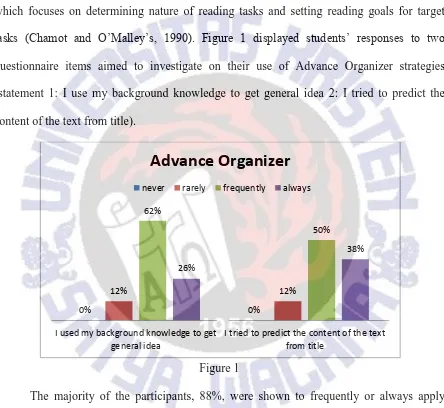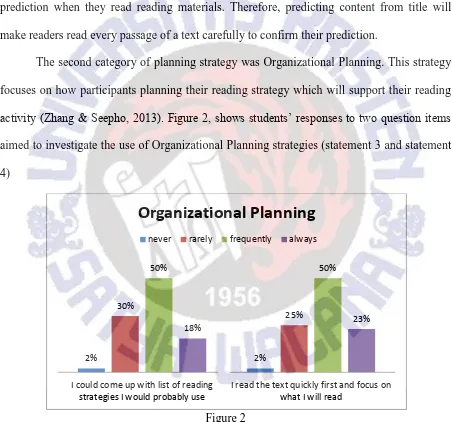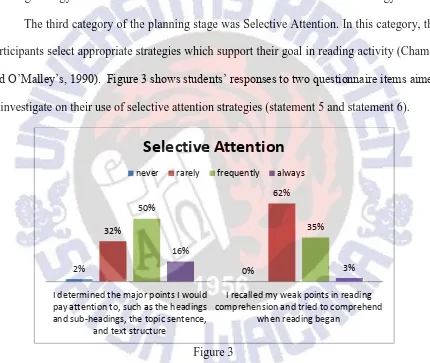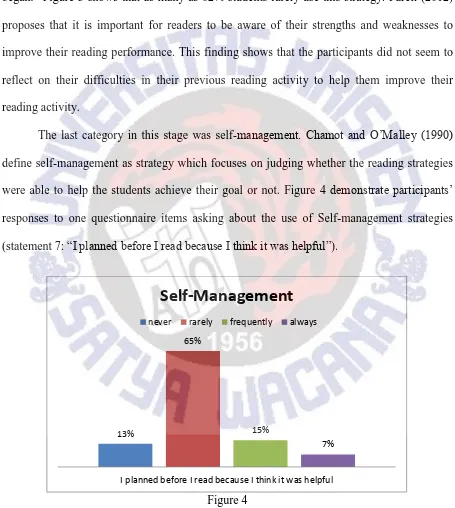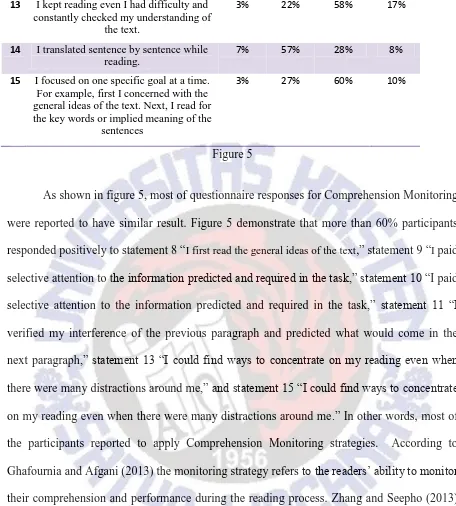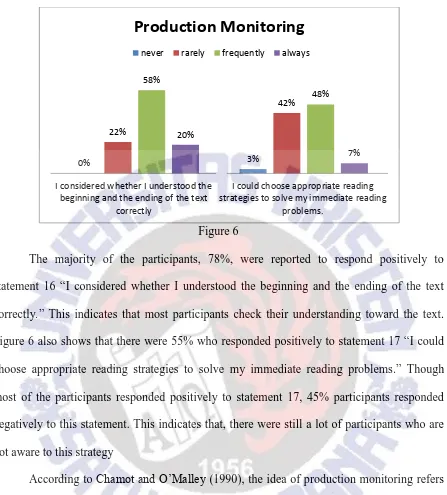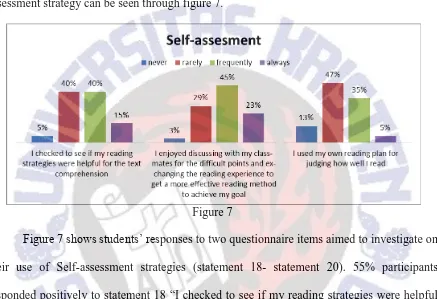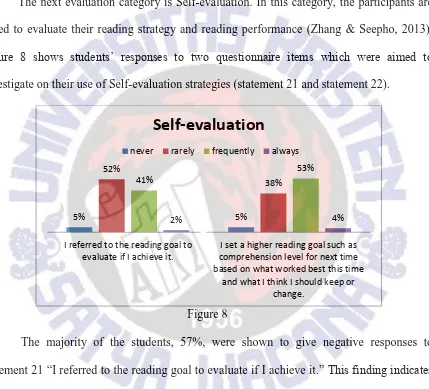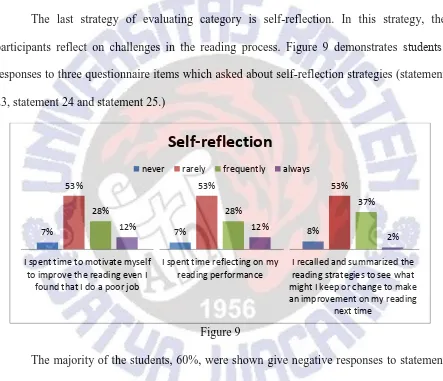INVESTIGATION OF METACOGNITIVE READING STRATEGY IN ACADEMIC WRITING CLASS
THESIS
Submitted in Partial Fulfillment of the Requirement for Degree of
Sarjana Pendidikan
Permata Dipaning Ratri 112012016
ENGLISH LANGUAGE EDUCATION PROGRAM FACULTY OF LANGUAGE AND LITERATURE
INTRODUCTION
Reading is an active process where readers need to understand direct and indirect
meaning of a reading passage. Karbalei (2010) proposes that to comprehend a reading passage, readers should be able to connect their background knowledge with their linguistic
knowledge. This shows that in order to comprehend reading passages, readers must develop their reading skill. Grellet (1981) points out that developing reading skill not only help readers to improve their reading performance but also help readers to improve their language
proficiency.
In developing the readers’ reading skill, they need to develop their reading strategies.
If readers know strategies which suit to their learning style, it will bring them to be a successful reader. According to Ismail and Tawalbeh (2015), readers are required to apply effective reading strategies to improve their reading comprehension. Effective reading
strategies help readers to understand content of reading passages.
However, it seems that students have not known how to develop their reading
strategy. If they find difficulties in reading comprehension they tend to seek assistance from someone or other sources to help them to comprehend texts. Yet, this strategy seems ineffective because it requires more time. Phichard (2008) states that using dictionary is
helpful for the low-achieving students in comprehending reading text, but she emphasized that the use of dictionary in reading classes can lead readers to have shallow interpretation
because the reader will only focus on the part they read rather than comprehending the whole text. On the other hand, students who have developed their reading strategies usually tend to use their background information and make a hypothesis during the reading process.
However, sometimes those students are not aware of their own reading strategies.
In language learning, there are so many reading strategies used by the students; one of
such as background, cultural and linguistic information during the reading activity. Mctavis (2008, 406) states “metacognition is the process of thinking about one’s own thinking.” This
means that metacognition is an individual thinking process to comprehend direct and indirect ideas using our background knowledge, linguistic knowledge and other knowledge.
The research question of this study is “what kind of metacognitive strategy used by students in Academic writing class?” The context of the study is English Language Education
Program of Satya Wacana Christian University students who have already took Academic
writing course. This course was chosen as the context of the study because in this class the students were required to read academic text to develop their knowledge about academic
paper. Therefore, in order to produce a good academic paper, it was important for the students to comprehend content and know structures of academic papers. Since the students’ comprehension in reading activity played important role in this course, this study was aimed
to investigate on what kind of reading strategy applied by the students.
Through this research, it is hoped that the students and teachers will be aware of metacognitive reading strategy. The awareness of this strategy will improve the students’
comprehension in reading a text. Besides that, the teacher could also realize the importance of metacognitive reading strategy so they can motivate the students to use the strategy to support
their learning process.
LITERATURE REVIEW
Metacognition: thinking beyond thinking
Metacognition was first introduced by Flavell in 1976. Flavell (1976) as cited in Iwai
(2011) defines metacognition as individual knowledge concerning in the individual cognitive process. This definition is similar with Zhang’s (2013) who states that metacognitive
cognitive processes and contitute an attempt to regulate ones’ own learning by means of
planning, monitoring, and evaluating” (p. 55). Then Hatami and Moghaddam (2014) add that metacognition is people’s awareness of their knowledge about what they know and what they
do not know. They also proposes that metacognition is an ability in understanding,
controlling and planning their cognitive process Therefore, metacognition in here is defined as people awareness of the process of their thinking. It refers to the process of planning, understanding and monitoring their thoughts during process of thinking.
The use of metacognitive strategy in reading
Many researchers have defined metacognition as a higher level of individual thinking.
In reading, metacognition strategy refers to the reading strategies which are planned to achieve the readers’ goal with considering individual prior knowledge (Zhang, 2013).
Alsheikh (2011) points out that the use metacognitive activities such as planning, checking,
evaluating, understanding, monitoring and reasoning are helpful for the learners to improve their reading comprehension. Ahmadi, Ismail, and Abdullah (2013) states that to develop
metacognitive awareness in reading activity, the learners should not only focus on getting the ideas of a text, but also focus on designing effective reading strategy to grasp the information. Thus, metacognitive strategies are important in reading comprehension because it will assist
the students to improve their reading comprehension. Zhang (2001) as cited in Iwai (2011) found out that advance learners tend to use metacognitive reading strategies to achieve their
reading goal. Therefore, the use of metacognitive strategies is very important in developing students reading comprehension.
Classification of metacognitive strategies
Oxford (1990) classifies metacognitive strategy into three main classifications. Those strategies are centering your learning, arranging or planning your learning, and evaluating
1. Centering your learning
This classification focus on how learners find important points of a text. This
classification is divided into three strategies, which are:
a. Overviewing and Linking with already Known Material
In this strategy, learners connect their existing knowledge and background information to comprehend the text.
b. Paying attention
In this strategy, learners pay attention to information which is useful for achieving their reading goal.
c. Delaying speech production focus on listening
This strategy is applied more in speaking and listening class. The idea of this strategy is students can develop their speaking skill trough listening activities.
2. Arranging and planning your learning
This classification focuses on the strategies concerning on learning process,
organizing, and setting learning goal. a. Finding out about language learning
This strategy focus on how learners look for the information that will help
them to accomplish their task b. Organizing
In this strategy, learners set comfortable environment that will help them focus on comprehending the task.
c. Setting goals and objectives
Learners need to identify the aim of the task so they are able to accomplish their task
e. Planning for language task
In this strategy, learners predict what kind of task that may occur in the future
and plan strategies to accomplish their prediction tasks. f. Seeking practice opportunities
This strategy usually used in writing and speaking activity. In this strategy,
learners were required to practice their language skill to improve their language ability.
3. Evaluating your learning a. Self-monitoring
This strategy is a strategy in which learners focus on monitoring their
performance in doing the task. b. Self-evaluation
Through this strategy, learners evaluate their progress in language learning. Similar with Oxford, O’Malley and Chamot’s (1990, cited in Vlckova, Berger and Vokle, 2013) classify metacognitive strategies into three classifications. Vlckova, Berger and Vokle (2013) states that O’Malley and Chamot categorize metacognitive strategy based on
the psychological function. There are three classifications of metacognitive strategy by O’Malley and Chamot’s (1990, Vlckova, Berger and Vokle, 2013)
1. Planning
Planning in metacognitive strategy refers to strategy which happens before the main
reading. This strategy focuses on planning the learning strategy and setting goal of language learning. In this strategy there are four categories which are Advance
2. Monitoring
Strategies included in this monitoring category are strategies which are used in the
process of learning. In this strategy, the learners need to check and try to understand the content of the task. The strategies included in this classification are Comprehend
Monitoring, and Produce Monitoring. 3. Evaluation
Evaluation is classification of strategies which are applied after doing the main
learning activity. In this strategy, learners tries to evaluate and asses themselves in doing their task. The strategies included in this classification are Self-assessment,
Self-evaluation, and Self-reflection.
Comparing both of classification, Oxford’s (1990) and O’Malley’s and Chamot’s
(1990) classifications are actually sharing almost the same idea. Vlcova, Berger and Volke (2013) points out that both of the classification has similar idea. However, in the Oxford’s
(1990) classification it looks more focus on strategies in comprehending tasks. This is
different with O’Malley and Chamot’s (1990) classification which focus on the strategy used during learning processes. According to Zhang and Seepho (2013), Chamot and O’Malley’s
(1990) classification allowed the students to comprehend their task in more systematic way.
Since this research will discuss about what kind of metacognitive strategies which were applied by the students in the process of learning. This research focuses on the Chamot and O’Malley’s (1990) classification.
Result from previous studies
Ismail and Tawalbeh (2015) found that metacognitive strategy helped the students to
improve their English language reading comprehension. This finding was found through comparing two groups of low-achieving EFL students. One of the groups was a control group
strategies. On the other hand, another group was an experimental group which was introduced to metacognitive reading strategies. The result of the experiment showed that the
experimental group was more aware of the reading strategy and was able to plan their reading strategy during the reading session. A similar finding was also presented by Zhang and Wu (2013) who discovered that the students’ reading strategies were positively correlated to the
EFL students’ achievement in reading comprehension.
Another research that investigated metacognitive strategy was the research by Nguyen
and Trinh (2011) who found that high achieving EFL students were good at planning and providing themselves with possible aids to increase their understanding. This research also
found that low-achieving EFL students tend to use monitoring strategy but not as often as the high-achieving students.
THE STUDY
The context of the study
This study took place in the Academic Writing course of the English Language Education Program of Satya Wacana Christian University. There were five classes of this course with four different lecturers. This course was intended to prepare the students to
produce a good academic paper. In this class, the students practiced to write academic papers. Besides writing the academic papers, the students were also required to read some journal
articles to learn more about academic essays. Through this reading activity, it was hoped that the students would know how organize an academic text and how to deliver their ideas into an academic text.
Participants
The total participants in this research were 60 students of English Language
batch 2014. Most of the participants stated that the English text that they usually read was stories or novel, news and course material. Most of them were reported to spent
approximately 5 -8 hours per week to read. In the table below the demographic information of the participants will be presented:
Table 1. Demographic information of the participants Gender
Age 18 19 20 >20
female 1 22 8 4
male 1 15 7 2
Besides the age and the gender, the demographic information also reveals that most of
the students had started to learn English since primary school. There were 50 students who stated that they learned English for the first time in the primary school and there were 8 participants who stated that they started learning English during their kindergarten. There
were also 2 participants who started learning English when they entered Junior High school. This shows that most of the participants have similar periods of learning English.
Instrument
This research tried to answer the research question “what kind of metacognitive study
that is used by Academic writing students? For answering that question, this research decided
to use Metacognitive Strategy Questionnaire (MSQ) to gather the data. The questionnaire was adapted from Zhang and Seepho (2013) because this questionnaire interpreted Chamot and O’Malleys’ classification of metacognitive strategy in more systematic way. The question
also presented detailed strategies which the students probably used. The questionnaire were likert-scale questionnaire with five answers but for gathering the data this research used four
study. The items 1-7 were classified as planning strategy. Items 8-17 were classified into monitoring strategy and item 18-25 were classified into evaluating strategy.
Data Collection Procedures
For the first step of gathering the data, I selected the question items of the
questionnaire and simplify the language so the participants understand all of the questions. Then, to validate and to ensure the entire question items were understood by the participants, I did piloting with 14 participants in one of academic writing class. Then, I checked the participants’ answers of the questionnaire. The result of the piloting showed that most of the
participants understood all of the question items. However there were two participants who did not give their answer to one of the question item. The question item was “I could come up
with list of reading strategies, I would probably use.” To make the students have better
understanding to this question. I decided to put example of reading strategies so the students
can understand the question. Besides that I also decided to clarify the demographic information asking about the participants’ period of learning English. Some of piloting
participants were confused weather it asked about the period learning English in the Faculty Language and Literature or the whole period they study English. To clarify this question I changed it into a question which asked how long they study English. After revising the
questionnaire I went to four different classes to distribute the questionnaire.
Data Analysis Procedures
After distributing the questionnaire, the data were transferred into Microsoft Excel. Then, I counted the percentages of the participants’ answers to know the majority of the participants answer. After counting the percentages, each question items was categorized into Chamot and O’Malley’s (1990) classifications. Next, the data was interpreted according the
classification to discover what kind of metacognitive strategies used by the students of
FINDINGS AND DISSCUSION Pre-reading strategies: Planning
Planning is a category for strategies which are applied before the reading activity.
There are four strategies which belong to this category. The First one was Advance Organizer which focuses on determining nature of reading tasks and setting reading goals for target tasks (Chamot and O’Malley’s, 1990). Figure 1 displayed students’ responses to two
questionnaire items aimed to investigate on their use of Advance Organizer strategies (statement 1: I use my background knowledge to get general idea 2: I tried to predict the
content of the text from title).
Figure 1
The majority of the participants, 88%, were shown to frequently or always apply strategies conveyed by statement 1. This finding reveals that the students had a positive attitude toward this statement. Alyousef (2005) proposed that background knowledge helps
readers to comprehend information in a text. Hajikata, Nakatami, and Shimizu (2013) also points out that activating background information related to text’s topic would help readers to
0% 0%
12% 12%
62%
50%
26%
38%
I used my background knowledge to get general idea
I tried to predict the content of the text from title
Advance Organizer
grasp the information. Therefore, applying the background information to get general idea will be helpful to the reader to understand the content of the text.
Similar to statement 1, students responded positively to statement 2. Figure 1 demonstrate that most students, 88%, were frequently and always use strategy delivered by
statement 2. According to Mistar, Zuhairi and Yanti (2016), prediction made the reading process become more active because the reader will constantly predict and check their prediction when they read reading materials. Therefore, predicting content from title will
make readers read every passage of a text carefully to confirm their prediction.
The second category of planning strategy was Organizational Planning. This strategy
focuses on how participants planning their reading strategy which will support their reading activity (Zhang & Seepho, 2013). Figure 2, shows students’ responses to two question items
aimed to investigate the use of Organizational Planning strategies (statement 3 and statement
4)
Figure 2
As shown in Figure 2, there were 50% participants who frequently and 18 % participants who always apply strategies conveyed by statement 3. The question of this item is “I could come up with list of reading strategies I would probably use.” Figure 2 also
2% 2%
30%
25%
50% 50%
18%
23%
I could come up with list of reading strategies I would probably use
I read the text quickly first and focus on what I will read
Organizational Planning
reveals that as many as 73% participants responded positively toward statement 4 which asked “I read the text quickly first and focus on what I will read.”
The result of the finding indicates that participants are aware of Organizational Planning strategies. This finding has different result compare to Zhang and Seepho’s (2013)
research which found that participants of their research did not apply Organizational Planning strategies. Zhang and Seepho (2013) point out that the participants avoided Organizational Planning strategy because the students were not aware and familiar with this strategy.
The third category of the planning stage was Selective Attention. In this category, the participants select appropriate strategies which support their goal in reading activity (Chamot and O’Malley’s, 1990). Figure 3 shows students’ responses to two questionnaire items aimed
to investigate on their use of selective attention strategies (statement 5 and statement 6).
Figure 3
The majority of the participants, 66%, were shown to apply reading strategies conveyed by statement 5 “I determined the major points I would pay attention to, such as the
Abdullah (2013), with paying attention to important points in a text, students can construct their own meaning of the text so they can comprehend the ideas of text.
Unlike statement 5, Most of the students responded negatively to statement 6 “I recalled my weak points in reading comprehension and tried to comprehend when reading
began.” Figure 3 shows that as many as 62% students rarely use this strategy. Farell (2012) proposes that it is important for readers to be aware of their strengths and weaknesses to improve their reading performance. This finding shows that the participants did not seem to
reflect on their difficulties in their previous reading activity to help them improve their reading activity.
The last category in this stage was self-management. Chamot and O’Malley (1990) define self-management as strategy which focuses on judging whether the reading strategies were able to help the students achieve their goal or not. Figure 4 demonstrate participants’
responses to one questionnaire items asking about the use of Self-management strategies (statement 7: “I planned before I read because I think it was helpful”).
Figure 4
The questionnaire responses showed that there were 65% participants who rarely used
strategies conveyed in statements 7. There were also 13 % participants who reported to never 13%
65%
15%
7%
I planned before I read because I think it was helpful
Self-Management
plan their reading strategy. This result indicates that planning strategies for reading were rarely used by participants.
Finding of this research showed that although most of the students were aware of metacognitive reading strategy. Most of them think did not need to apply self-assessment
strategy because they seemed to think that this strategy did not give significant impact to their reading performance. Vlcvova, Berger and Vokle (2013) stated that main idea of metacognitive awareness was self-control. Therefore, controlling our own reading strategy
was important to achieve our reading goal.
Whilst Reading Strategy: Monitoring
Monitoring was category which is applied while participants or readers do their reading activity. There were two categories of strategies belong to this strategy. The first strategy was Comprehension Monitoring. Chamot and O’Malley (1990) stated that this
strategy related to the participants strategies to monitor or check their reading comprehension during reading activity. Figure 5 shows students’ responses to 8 questionnaire items which
are used to check students’ response toward comprehension monitoring strategies (statement 8 – statement 15)
Statement never rarely frequently always
8 I first read the general ideas of the text 0% 9% 63% 28%
9 I paid selective attention to the information predicted and required in the
task
3% 27% 58% 12%
10 I verified my interference of the previous paragraph and predicted what would
come in the next paragraph
2% 37% 51% 10%
11 I could find ways to overcome the
problems when I got stuck with difficult vocabulary
0% 15% 58% 27%
12 I could find ways to concentrate on my reading even when there were many
distractions around me.
13 I kept reading even I had difficulty and constantly checked my understanding of
the text.
3% 22% 58% 17%
14 I translated sentence by sentence while reading.
7% 57% 28% 8%
15 I focused on one specific goal at a time. For example, first I concerned with the general ideas of the text. Next, I read for the key words or implied meaning of the
sentences
3% 27% 60% 10%
Figure 5
As shown in figure 5, most of questionnaire responses for Comprehension Monitoring were reported to have similar result. Figure 5 demonstrate that more than 60% participants
responded positively to statement 8 “I first read the general ideas of the text,” statement 9 “I paid selective attention to the information predicted and required in the task,” statement 10 “I paid
selective attention to the information predicted and required in the task,” statement 11 “I verified my interference of the previous paragraph and predicted what would come in the next paragraph,” statement 13 “I could find ways to concentrate on my reading even when
there were many distractions around me,” and statement 15 “I could find ways to concentrate on my reading even when there were many distractions around me.” In other words, most of
the participants reported to apply Comprehension Monitoring strategies. According to Ghafournia and Afgani (2013) the monitoring strategy refers to the readers’ ability to monitor their comprehension and performance during the reading process. Zhang and Seepho (2013)
states the students or reading with lower proficiency is unable monitor their own reading performance because lack of linguistic knowledge will make the students have poor
Though most of the questions for this strategy show similar results, there were also questions that have different responses. Figure 5 shows that only 50% of the participants
respond positively toward statement 12 “I could find ways to overcome the problems when I got stuck with difficult vocabulary.” This indicates that the half of the participants were still
able to focus on the reading comprehension though there were distraction around them. According to Oxford (1990), readers should set comfortable environment so they can concentrate to their reading activity. The students who are able to find their way to focus on
reading activities show that they can overcome distractor around them easily.
The next item which has a different result is statement 14, which asked about
translating strategy in reading. As many as 64% participants claimed that they rarely translate sentence by sentence during their reading activity. This shows that this strategy has been left by the students. Liao (2006) states that though translation strategies can facilitate the students
to comprehend the learning strategy, more proficient readers responded negatively toward this strategy because the students thought that the use of translating strategy will infer their
English comprehension.
The second category in this stage was Production Monitoring. This strategy focuses on monitoring reading comprehension to check readers understanding toward reading materials. Figure 6 shows students’ responses to two questionnaire items which aimed to
Figure 6
The majority of the participants, 78%, were reported to respond positively to statement 16 “I considered whether I understood the beginning and the ending of the text correctly.” This indicates that most participants check their understanding toward the text.
Figure 6 also shows that there were 55% who responded positively to statement 17 “I could choose appropriate reading strategies to solve my immediate reading problems.” Though
most of the participants responded positively to statement 17, 45% participants responded negatively to this statement. This indicates that, there were still a lot of participants who are not aware to this strategy
According to Chamot and O’Malley (1990), the idea of production monitoring refers to the monitoring process before starting to produce something. Students need to comprehend
their reading task in order to re-produce their reading text as a source. The purpose of this stage is also to check whether strategies learned by students are useful to produce a certain text or not. Therefore, it is important to familiarize students with Production Monitoring
strategy, because through this strategy helps students to transfer their reading information to produce new materials.
0% 3%
22%
42% 58%
48%
20%
7%
I considered whether I understood the beginning and the ending of the text
correctly
I could choose appropriate reading strategies to solve my immediate reading
problems.
Production Monitoring
Post reading strategy: Evaluating
Evaluating is post reading activity where readers evaluate their own reading
performance. This stage is divided into three different categories. The first category for this stage is Self-Assessment. In this category, participants assess themselves whether they have
accomplished their reading goal or not (Zhang and Seepho, 2013). The finding of the self-assessment strategy can be seen through figure 7.
Figure 7
Figure 7 shows students’ responses to two questionnaire items aimed to investigate on
their use of Self-assessment strategies (statement 18- statement 20). 55% participants responded positively to statement 18 “I checked to see if my reading strategies were helpful
for the text comprehension.” This finding reveals that the majority of the participants assess weather their reading strategies are helpful or not. Similar with statement 18, statement 19 “I enjoyed discussing with my class-mates for the difficult points and ex-changing the reading
experience to get a more effective reading method to achieve my goal” also receive positive responses from the participants. Figure 7 shows that most participants, 68%, frequently or always discuss their difficulties to their classmate. Unlike other strategy, the third strategy of
this category gets more negative responses from most participants. 60% of them are reported to rarely or never use the strategies delivered by statement 20 “I used my own reading plan
From the data finding, it can be seen that most of the participants seemed to be aware of the need to assess themselves to improve their reading performance. Baniabdelrahman
(2010) states that self-assessment helps the students to be aware of their performance. The students who are aware of their reading performance can motivate themselves to set higher
goal to improve their performance when do other task.
The next evaluation category is Self-evaluation. In this category, the participants are asked to evaluate their reading strategy and reading performance (Zhang & Seepho, 2013). Figure 8 shows students’ responses to two questionnaire items which were aimed to
investigate on their use of Self-evaluation strategies (statement 21 and statement 22).
Figure 8
The majority of the students, 57%, were shown to give negative responses to statement 21 “I referred to the reading goal to evaluate if I achieve it.” This finding indicates that the students do not seem to reflect on their reading goal to ensure that they have achieved
all of their reading goals. On the other hand, 57% participants were reported to set higher goal and reflect on their strengths and weakness after doing the reading activity. This reveals
that the majority of the students respond positively toward statement 22 “I set a higher reading goal such as comprehension level for next time based on what worked best this time
and what I think I should keep or change
.”
5% 5%
I set a higher reading goal such as comprehension level for next time based on what worked best this time
and what I think I should keep or change.
Self-evaluation
The finding shows that there is only little gap between students who apply strategies and students who do not apply strategies conveyed by the statements. Zhang and Sheepho
(2013) state that for some of EFL students, self-evaluating is unfamiliar because they believe only teachers who have authority to evaluate their performance. The data finding which
shows little gap indicates that participants start aware of self-evaluation. Yet, they seem hesitated to apply this strategy because of their belief.
The last strategy of evaluating category is self-reflection. In this strategy, the
participants reflect on challenges in the reading process. Figure 9 demonstrates students’ responses to three questionnaire items which asked about self-reflection strategies (statement
23, statement 24 and statement 25.)
Figure 9
The majority of the students, 60%, were shown give negative responses to statement 23 “I spent time to motivate myself to improve the reading even I found that I do a poor job.”
This finding reveals that the students might not motivate themselves to improve their reading performance. Most students 60% also did not give positive reaction to statement 24 “I spent
time reflecting on my reading performance.” This shows that students did not seem spend their time to reflect to their reading performance. The last statement of this category also did
not receive positive responses from most participants. There were 61% participants who
reported to rarely and frequently use the strategy conveyed by statement 25 “I recalled and summarized the reading strategies to see what might I keep or change to make an
improvement on my reading next time.”
Referring to Zhang and Seepho (2013), self-reflection strategy has strong relation with the students’ cultural background. The result of the data which shows that most of the
students rarely used self-reflection indicates that students might not familiar with this strategy. Therefore, teachers should encourage students to do self-reflection after finishing
their reading activity.
CONCLUSION
The aim of the study is to investigate the use of metacognitive strategies in Academic Writing course. This research found that most of the planning strategies were applied by the majority of the participants. In this category, there were two strategies which were less used.
Those strategies were recalling their past weaknesses of their reading activity and planning reading strategy to help their reading activity. Through this study, it was found out that
students still lacked awareness of reflecting to their past mistake so it seems difficult for them to plan strategies to improve their reading performance. This study also reveals that the majority of the participants did not seem to realize the importance of planning their reading
strategy to improve their reading comprehension.
The second finding shows that most of the monitoring strategies were applied by the
participants. In this study, there were two strategies which were less used by the participants. One of those strategies was translating strategy which helped the students to monitor their understanding toward the reading text. However, it seems to take more time to use this
strategy so this strategy was not applied by students in their reading activity. Besides that strategy, there were 50% participants who stated that they could not find ways if there were
The third finding showed that the participants responded negatively to the evaluation strategy. In this category, the participants only showed positive reaction on three questions
items. The first items asked whether the students can find the strategies to keep focus in their reading activity even though they have many distractions. The second one asked whether the
participants discuss their reading material with their friends. The last one asked about the participants’ reflection toward their goal.
From the result of the study, it can be concluded that the planning and monitoring
strategies had already received attention from the participants though not all the strategies were applied by them. On the other hand, the evaluating strategies were less used. Therefore
the implication of the study showed that the teacher should introduce the students how to evaluate themselves in the reading activity. Through assessment, evaluation and self-reflection, the students can know their progress in comprehending a text. Besides that, the
students also can improve their reading performance. To introduce evaluation strategies to the students, the teachers can guide students with giving some question that require the students to reflect on their reading activity. Questions like “what can you learn from the text?” or just
asking about their opinion about the material they read will encourage students to reflect to their reading performance weather they have already comprehend the reading material or not.
The result and finding of this study cannot be generalized, because this research only held on a particular context which is the Academic Writing class. Moreover the participants
were less than 100 participants. For further research, the study can used more participants and the future researcher can add more instruments like semi-structured interview to find out the reason of why they used or did not use certain strategy. Through the semi-structured
ACKNOWLEDGEMENT
I would like to express my gratitude to God for his blessing. I would also like to thank
my thesis supervisor, Anita Kuriniawati H., M.Hum. for guiding and motivating me to finish my thesis. I also want to express my gratitude to my second reader, Elisabeth Titik Murtisari,
REFERENCES
Ahmadi, M. R., Ismail, H. N., & Abdullah, M. K. (2013). The importance of metacognitive reading strategy awareness in reading comprehension. English Language Teaching, 6(10), 235-244.
Alsheikh, N. O. (2011). An examination of the metacognitive reading strategies used by native speakers of arabic when reading in english and arabic. English Language Teaching, 4(2), 151-160.
Alyousef, H. S. (2005). Teaching reading comprehension to ESL/EFL learners. The Reading Matrix, 5(2), 143-154
Baniabdelrahman, A. A. (2010). The effect of the use of Self-Assessment on EFL students’ performance in reading comprehension in English. Teaching English as a Second or Foreign Language, 14(2).
Flavell, J. (1979). Metacognition and cognitive monitoring: A new area of cognitive developmental inquiry. American Psychologist, 34, 906–911.
Farrell, T. S. (2012). Reflecting on teaching the four skills: 60 strategies for professional Development. Michigan: University of Michigan Press.
Ghafournia, N., & Afghari, A. (2013). Relationship between reading proficiency, strategic competence, and reading comprehension test performance: A study of Iranian EFL learners. International Education Studies, 6(8), 21-30.
Grellet, F. (1981). Developing Reading Skills: A Practical Guide to Reading Comprehension Exercise. Cambridge: Cambridge University Press
Hajikata, Y., Nakatami, Y., & Shimizu, M. (2013). Japanese EFL Students' Reading process for academic papers in English. Journal of Education Learning, 2(1), 70-83.
Hatami, A., & Moghaddam, H. H. (2014). Analysis of the effect of metacognition on educational progress of students in topic of logarithm. International Journal of Education and Research, 2(7), 565-570.
Ismail, N. M., & Tawalbeh, T. I. (2015). Effectiveness of a metacognitive reading strategies program for improving low achieving EFL readers. International Education Studies, 8(1), 71-87.
Iwai, Y. (2011). The Effects of Metacognitive Reading Strategies: Pedagogical Implications. The Reading Matrix, 11(2), 150-159.
Karbalei, A. (2010). A comparison of the metacognitive reading strategies used by EFL and ESL readers. The Reading Matrix, 10(2), 165-180.
Liao, P. (2006). EFL learners' beliefs about and strategy use of translation in English learning. Regional Language Centre Journal, 37(2), 191-215.
McTavish, M. (2008). "What were you thinking?": The use of metacognitive strategy during engagement with reading narrative and informational genre. Canadian Journal of Education, 2(31), 405-430.
Mistar, J., Zuhairi, A., & Yanti, N. (2016). Strategies trainning in teaching reading comprehension for EFL learners in Indonesia. English Language Teaching, 9(2), 49-56.
Nguyen, T. M., & Trinh, L. Q. (2011). Learners' metacognitive strategy use and reading comprehension: Insight from a Vietnamenese context. Journal on English Language Teaching,, 1(1), 9-19.
O Malley, J. M., & Chamot, A. U. (1990). Learning Strategies in Second Language Acquisition. Cambridge: Cambridge University Press.
Oxford, R.L. (1990). Language Learning Strategies: What Every Teacher Should Know. boston: Heinle & Heinle.
Pigada, M., & Schmitt, N. (2006). Vocabulary acquisition from extensive reading: A case study. Reading in a Foreign Language, 18(1), 1-28.
Phichard, C. (2008). Evaluating readers' vocabulary strategies and dictionary use. Reading in Foreign Language(2), 216-231.
Taguchi, E., Takayasu-Maass, M., & Gorsuch, G. J. (2004). Developing reading fluency in EFL: How assisted repeated reading and extensive reading affect fluency. Reading in a Foreign Langauge, 26(2), 70-96.
Vlckova, K., Berger, J., & Vokle, M. (2013). Classification theories of language learning strategies: An explanatory analysis. Studia paedagogica, 18(4), 93-114.
Zhang, L. J. (2001). Awareness in reading: EFL students’ metacognitive knowledge of reading strategies in an acquisition-poor environment. Language Awareness,10(4), 268-288.
Zhang, L., & Seepho, S. (2013). Metacognitive strategy use and academic reading achievement: Insight from a Chinese context. Electronic Journal of Foreign Language Teaching, 10(1), 54-69.
Appendix: the instrument of the research
Before I started reading an English text, … Ite 1 I used my background knowledge to get
general idea information in a text; scanning: read the text quickly) and sub-headings, the topic sentence, and text structure information predicted and required in the task
3
8

